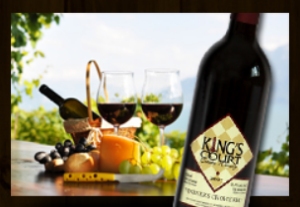 Wine lovers, I hope you enjoy “The Winemaker’s 7 Essential Tips For Serving Wine With The Best Results!” from Roland Zimmermann, co-owner and winemaker of King’s Court Estate Winery.
Wine lovers, I hope you enjoy “The Winemaker’s 7 Essential Tips For Serving Wine With The Best Results!” from Roland Zimmermann, co-owner and winemaker of King’s Court Estate Winery.

By Roland Zimmermann
As you likely already know, hosting a successful dinner party means pairing wines with the appropriate cuisine. Most food and wine experts believe that specific wine varieties simply taste better with certain foods, matching the strengths of the wine to the cuisine. Conversely, pairing wines with a proper wine glass remains an afterthought for many a bottle of deserving wine.
Connoisseurs maintain that stemware has a definite effect on nose and palate. Studies indicate that a white wine bouquet becomes lost in a large, open-rimmed vessel, allowing quick oxidation and the escape of delicious aromas without so much as a single whiff. Smaller, tulip-shaped stemware collects and circulates white wine aromas with just the right amount of oxygen to enhance the experience, providing the sensory introduction our winemaker intended.
Debate continues over construction materials, with many fans in the crystal camp. Crystal is strengthened by the addition of lead to molten glass. Superior sparkle aside, lead allows the bowls to be quite thin, enabling a more intimate sip with a thin edge that does not disrupt the wine on the way to the palate, delivering a smooth, supple sip. Additionally, for those concerned with regard to lead, there are crystal wine glass manufacturers that make excellent lead-free options.

The ideal bowl size for white wines is 350 ml (12-14 ounces), with a pour filling just one-third of the glass. The bowl should be narrow, keeping surface area to a minimum, preventing the wine from warming.
And what of the plastic wine glass? Most plastics are made from petrochemicals that continually outgas chemistry, affecting nose and taste. Plastic stemware, while constructed with proper architecture, cannot escape its material genetics.
Recently, stemless glassware has come into vogue as a more casual serving style. Attractive for its compact nature, the glass fits nicely into dishwashers and cabinets. The stems are an important component, however, as they serve a useful purpose, keeping the warmth of the hand from altering the temperature of the wine in the glass. Holding a stemless glass in the hand transfers body heat into the glass, warming the wine and affecting the taste.
Stemware that shows off the colour of the wine while maximizing the experience on the nose and palate is the goal. Thin, clear stemware, made of high quality glass or crystal, will give the wine an opportunity to shine, highlighting its best. Thick, coloured or patterned glassware highlights the vessel, taking away from the precious liquid within. We encourage making the most of every bottle, with proper consideration for grape variety, winemaking, storage, and serving temperature. It seems only prudent to continue that pursuit of excellence by selecting an appropriate glass for the pour.
“Ein Prost!”
See also…
Winemaker Tip #1. The Corkscrew: Cut, Twist, Pull
Winemaker Tip #2. A Matter of Degree: Temperature & Wine
Winemaker Tip #4. Red Wine Stemware: Passionate Presentation
Winemaker Tip #5. Stemware for Dessert Wines: Short & Sweet
Winemaker Tip #6. Wine & Cheese: Perfect Pairing
Winemaker Tip #7. Decanting Wine: Sediment & Evaporation
Tags: King's Court Estate Winery, Wine Tasting








